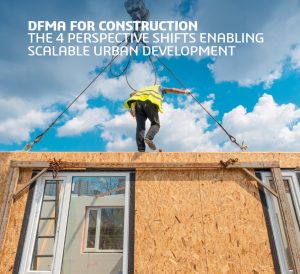The following article is excerpted from DFMA for Construction: The 4 Perspective Shifts Enabling Scalable Urban Development, a whitepaper developed by Dassault Systèmes. To read more, download the full whitepaper here.
Design for Manufacture and Assembly (DFMA) is the practice of prioritizing manufacturing realities and assembly workflows while designing a product experience. DFMA is possible through the combination of:
- Modular assemblies that reduce and simplify the interfaces between components
- Automated configuration through data-driven designs that are integrated with manufacturing parameters
DFMA, applied to any industry context, has proven benefits: accelerating the processes of design, manufacturing and assembly; improving quality and predictability; and reducing risk. When applied to industrialized construction techniques (i.e. off-site manufacturing, prefabrication, etc.), DFMA unlocks the true potential for construction teams to build at the scale necessary to keep pace with demand and create a competitive advantage.
The benefits of both prefabrication and modularized construction are widely recognized among advocates and driving a “significant expansion of interest and use” within the industry, . Practitioners agree:
- Improved productivity and quality are top benefits driving usage;
- Positive impacts on budget and schedule performance are widely experienced; and
- Construction sites are greener due to less waste being generated, and safer due to working with assemblies and modules produced offsite.
Unfortunately, the terms used in a discussion of DFMA principles are often conflated. These construction techniques complement each other but are in fact distinct.
Off-site construction may be used to describe the assembly of parts before they reach the construction site using processes similar to what would be found on-site. An off-site process improves workforce productivity and safety, although not as much as automation can enable.
Automated manufacturing describes heavily leveraging machines and model-based designs to prefabricate components. This approach reduces the need for labor overall and improves efficiency, traceability, productivity and quality. Automation is critical for gaining the maximum productivity benefits of an off-site approach.
Prefabrication is an umbrella term used to describe all processes in which some components are assembled prior to arriving on site. Often this term is too vague to identify the level of potential labor savings achievable.
Modular construction often refers to the process whereby transporting sections from the factory to the construction site requires them to be segmented without regard for on-site installation. If the interfaces between these components are such that skilled laborers or tradespeople are required to connect them, they have not been engineered as modules designed for efficient assembly.
Modularization is the engineering approach whereby the interfaces between components are reduced and simplified. The resulting modular components, or turnkey assemblies, are ideal for empowering unskilled labor to perform installation processes and making both off-site (preassembly) and on-site assembly phases more efficient and scalable.
Model-based design describes the use of a single, virtual, additive referential of a project with progressively increasing, dynamic datasets that communicate seamlessly. Physical, dimensional, characteristic and behavioral data are integrated into a single model that supports a project’s full lifecycle-from design to development to operation. In construction, a model-based approach incorporates geometry, systems, performance simulations, process simulations, requirements, constraints, timelines, approvals, manufacturing instructions, work packages and more.

Understanding this terminology is a primer to understanding the four key shifts that are driving how DFMA is changing the construction industry. Ready to see what they are? Download DFMA for Construction: The 4 Perspectives Shifts Enabling Scalable Urban Development.
Related link: Dassault Systèmes Construction, Cities & Territories Industry
